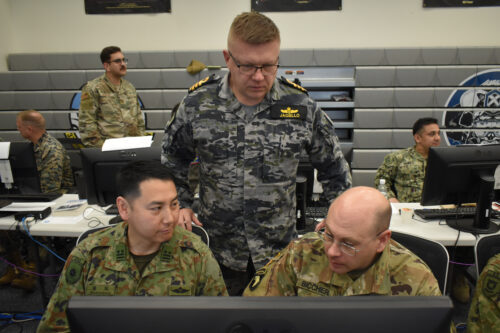Japan and the United States conducted a joint military exercise in February 2024 that simulated Japanese forces attacking Chinese vessels during a Taiwan invasion scenario, according to an exclusive report published by Sankei Shimbun on Apr. 6.

Photo by Gunnery Sgt. Jonathan Wright
The command post exercise, known as “Keen Edge,” marked the first time the two allies had comprehensively simulated a Taiwan contingency in their joint training. The results of the exercise are believed to have been incorporated into operational planning for both militaries.
According to multiple sources cited by Sankei, the exercise was conducted under the premise that Japan had established a Joint Operations Command, which was formally launched in March 2025. The simulation was partly intended as preparation for this new unified command structure.
In the exercise scenario, Chinese forces launched an invasion of Taiwan while simultaneously attacking U.S. military facilities in Japan, including the Sasebo Naval Base in Nagasaki Prefecture. Japanese officials determined that these actions did not constitute a direct “armed attack” on Japan that would trigger individual self-defense rights. However, they classified the Taiwan invasion as an “existential threat” to Japan’s security, which enabled the invocation of collective self-defense rights.
Following this decision, U.S. forces requested Japanese assistance in attacking a Chinese amphibious assault fleet traversing the Taiwan Strait. Japan agreed to the request, with Japan Air Self-Defense Force fighter jets deploying anti-ship missiles against Chinese transport vessels.
The exercise revealed several strategic considerations among Japanese defense planners. Some officials reportedly argued that Chinese aircraft carriers should be prioritized as targets over amphibious vessels. However, the decision was made that carriers operated by the Chinese military at that time were lower-priority targets.
The scenario also included Chinese forces landing on Yonaguni Island, Japan’s westernmost territory. The Japan Ground Self-Defense Force dispatched reinforcements from Kyushu to strengthen defenses across Japan’s southwestern islands. This created logistical challenges as both transport aircraft carrying troops and fighter jets needed to use the same runways, leading to debates over prioritization.
“It was a qualitatively superior exercise compared to past iterations,” Joint Staff Chief Yoshida Keishū was quoted as saying in the Sankei report. The exercise also featured the first-time participation of Australian forces, indicating expanding regional security cooperation.
Keen Edge is typically conducted every two years. The 2024 iteration reflects Japan’s evolving defense posture following reinterpretations of its constitution to allow for limited exercise of collective self-defense rights.
The simulation comes amid growing regional concern about Taiwan’s security and increasing military activities by China in the Taiwan Strait and surrounding areas.
For more information, hit the Source below